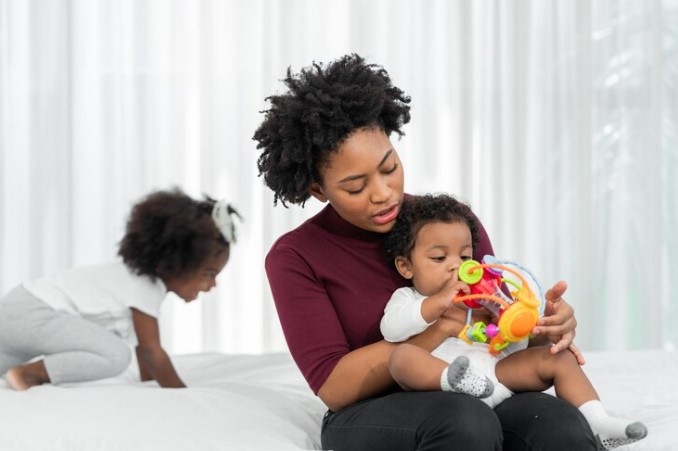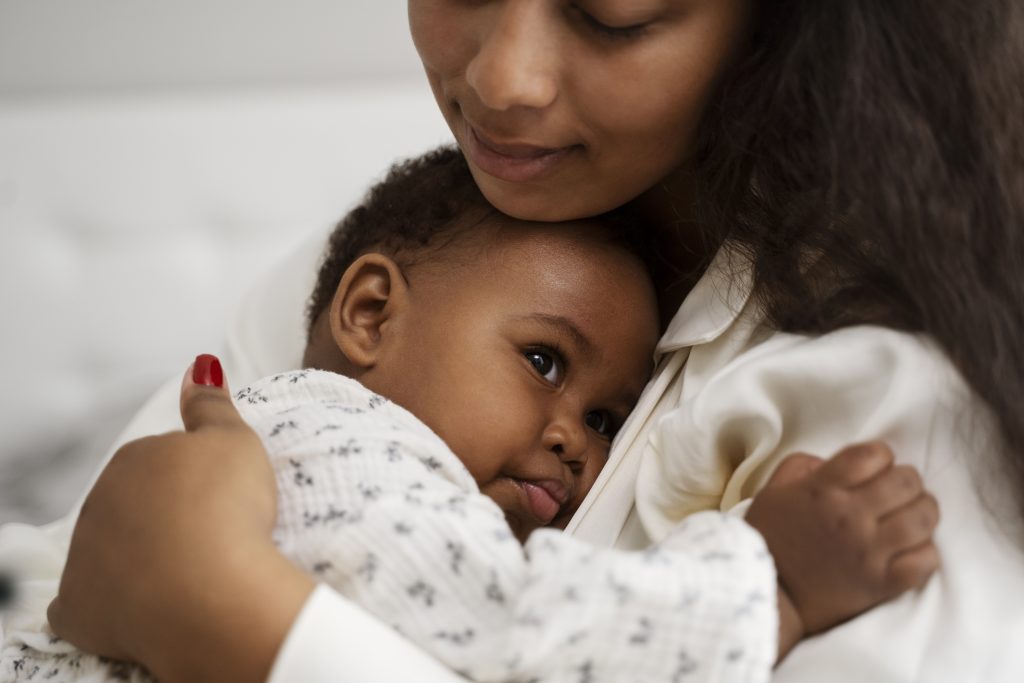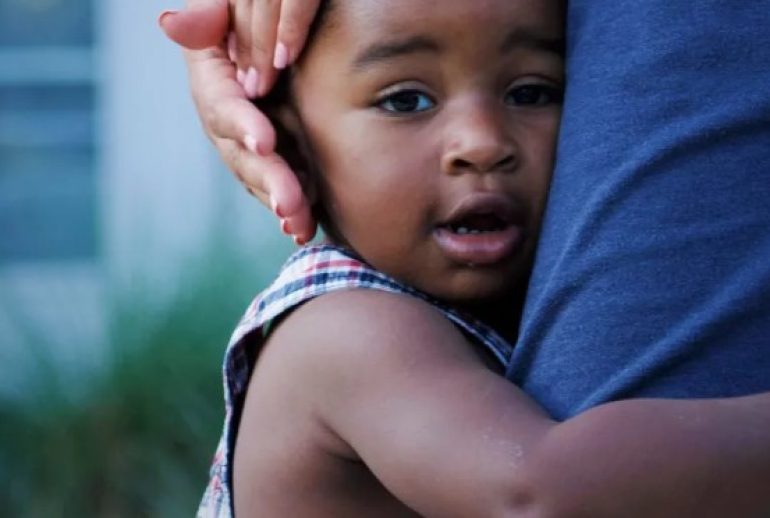If your little one is just resuming at creche or pre-school, that’s a huge milestone and you should be excited about it!
Yet, seeing that cute little face in distress can eat at you and deprive you of the joy that should accompany this milestone, leaving you instead with feelings of guilt and despair, especially as a first-time mom.
It’s okay mama, that feeling is perfectly normal!

Although it is very stressful for mums and their kids, separation anxiety is a sign of secure attachment. It is a normal response to the fear of being (momentarily) separated from those they trust and depend on for comfort and care. Infants experiencing this would usually be more clingy than usual, crying or screaming when you are about to leave their space.
It just shows that your little one is emotionally healthy and can form strong bonds with you or other primary caregiver(s) which is important for proper social and emotional functioning throughout life.
I remember dropping off my favorite niece on her first day in school, she was quite excited until it was time to say goodbye. I knelt down to hug her and tell her I love her and she wouldn’t let go. She started crying and I didn’t know what to do. So I started crying too (hard girl in the mud) forgetting I was the adult here, until the teachers came to my rescue. This continued for some days, until I got tired of falling my hand and decided to avoid taking her to school.
While most babies begin to experience separation anxiety around 6 -9 months and it may last until 2 – 3 years , some infants do not experience this until they are much older and others may never experience it at all.
Causes of Separation Anxiety In Babies
Separation Anxiety emerges in babies when they begin to understand object permanence: the consciousness that people/things continue to exist regardless of whether or not you can sense them.
However, they are yet to understand time, they don’t know if/when you’ll be back and this makes them anxious and agitated.
In addition to this, here are a few other things that can trigger separation anxiety in kids.
Change of Environment
Routines are quite important for our little ones as they depend on it to understand the world around them and it also provides a sense of predictability.
A familiar environment is part of what keeps them grounded and helps them feel safe. A change in environment tends to tilt this balance and can trigger this anxiety in kids.
When a change of environment is inevitable, it is pertinent to ensure that some form of normalcy is maintained around your kid to help them transition smoothly.
Change of Caregiver(s)
A new caregiver can be a bit unsettling for your little one, as they are yet to fully understand your child’s routine(favorite songs, phrases, meals) and can make them cranky.
Arrival of a new sibling

This can be overwhelming for everyone, children inclusive. That sudden shift in attention and love because of a little stranger in their home can have them feeling unseen and unsafe, and can cause them to resort to more clinginess.
Stress of a caregiver
Children feed off our energy as adults and can easily pick up on tension, stress induced or otherwise. Being self aware is crucial to maintaining emotional stability, especially around our little ones.
Loss of a parent/caregiver
This can be quite devastating for adults as well as kids. While they might be unable to grasp the extent of what’s happened, they seek comfort in familiar faces to give them a sense of normalcy.
Extended absence of caregiver
It could be due to a work trip or even Lagos traffic, whatever offsets the rhythm of a child’s world can cause separation anxiety to kick in.
Illness and Hunger
When they are tired, hungry or ill, they tend to get cranky and need extra support.
Common Signs of Separation Anxiety in Babies

These are some of the common signs of separation anxiety in babies
- Clinginess: Increased desire to be held or carried by a familiar person.
- Crying and Distress: Intense crying or distress when separated from a caregiver.
- Resistance to Strangers: Wariness or fear when approached by unfamiliar people.
- Sleep Changes: Disruptions in sleep patterns, with increased night waking or difficulty falling asleep.
While navigating the challenges of separation anxiety in our little ones, it is important for parents to remain vigilant and stay attuned to the signals our little ones are sending. Observing these signs is critical, as they might be indicative of emotions or situations that extend beyond typical separation anxiety.
Keep an open line of communication and seek professional guidance where necessary. This would help parents foster a supportive environment that addresses not only the immediate concerns of separation anxiety but also any underlying, more sensitive issues that may require attention and understanding.
At this point, you must be wondering: “how do I manage separation anxiety?” Stay tuned for the next article, where I’ll be sharing tips on handling separation anxiety in babies.
Be the first to get notified by joining Fusion’s Parenting Community
Click here to download Fusion






327 Responses
вывод из запоя в ростове-на-дону http://www.bisound.com/forum/showthread.php?p=1217039/ .
вывод. из. запоя. анонимно. ростов. [url=http://www.belbeer.borda.ru/?1-6-0-00000751-000-0-0-1730725764]http://www.belbeer.borda.ru/?1-6-0-00000751-000-0-0-1730725764[/url] .
Выбирайте играть в Лаки джет и начинайте получать доход от игры.
Выбирайте играть в Лаки джет, чтобы проверить свою реакцию и удачу.
Здесь можно преобрести сейф заказать сейф
вывод из запоя в ростове [url=www.angelladydety.getbb.ru/viewtopic.php?f=44&t=42909]www.angelladydety.getbb.ru/viewtopic.php?f=44&t=42909[/url] .
нарколог вывод из запоя ростов [url=https://alhambra.bestforums.org/viewtopic.php?f=2&t=46371/]alhambra.bestforums.org/viewtopic.php?f=2&t=46371[/url] .
Тут можно преобрести купить оружейный сейф доставка шкафы для оружия сейфы
Тут можно преобрести огнестойкий сейф купить сейф огнестойкий
You have remarked very interesting points! ps nice internet site. “Never take the advice of someone who has not had your kind of trouble.” by Sydney J. Harris.
алкоголизм лечение вывод из запоя ростов http://domsadremont.ukrbb.net/viewtopic.php?f=3&t=903 .
лучшие онлайн казино [url=http://www.casino-bonus.by]http://www.casino-bonus.by[/url] .
вывод из запоя цена ростов https://golosa.ukrbb.net/viewtopic.php?f=3&t=7467 .
вывод из запоя ростов-на-дону [url=http://stranaua.ukrbb.net/viewtopic.php?f=2&t=59747]вывод из запоя ростов-на-дону[/url] .
Bets10 giriş sayesinde herkes için rahat bir oyun deneyimi sunar. Kendinizi güvende hissedeceğiniz bir ortamda şansınızı deneyin!
Тут можно преобрести противопожарный сейф купить огнеупорный сейф
Тут можно преобрести сейфы для ружья купить сейф для ружья
вывод из запоя на дому ростов-на-дону http://www.aqvakr.forum24.ru/?1-7-0-00011570-000-0-0-1730648582 .
вывод из запоя в ростове [url=https://gaslo.ukrbb.net/viewtopic.php?f=13&t=3409/]gaslo.ukrbb.net/viewtopic.php?f=13&t=3409[/url] .
вывод из запоя цена ростов [url=http://www.cah.forum24.ru/?1-19-0-00000455-000-0-0-1730648785]http://www.cah.forum24.ru/?1-19-0-00000455-000-0-0-1730648785[/url] .
вывод из запоя круглосуточно http://www.bisound.com/forum/showthread.php?t=688674 .
Тут можно преобрести купить огнеупорный сейф купить огнестойкий сейф
Сервисный центр предлагает замена динамика lg kg280 замена экрана lg kg280
Use 888Starz promo code 888LEGAL and take advantage of exclusive rewards.
нарколог вывод из запоя ростов masa.forum24.ru/?1-16-0-00002618-000-0-0-1730649347 .
вывод из запоя ростов на дону на дому http://rubiz.forum.cool/viewtopic.php?id=3742/ .
вывод из запоя на дому ростов недорого [url=http://www.business.0pk.me/viewtopic.php?id=37942#p224618]http://www.business.0pk.me/viewtopic.php?id=37942#p224618[/url] .
вывод из запоя на дому ростов [url=https://vip.mybb.rocks/viewtopic.php?id=7670]https://vip.mybb.rocks/viewtopic.php?id=7670[/url] .
вывод. из. запоя. анонимно. ростов. [url=https://internetmoney.bestbb.ru/viewtopic.php?id=31697/]https://internetmoney.bestbb.ru/viewtopic.php?id=31697/[/url] .
Тут можно преобрести купить сейф для ружья сейфы для ружья
Здесь можно преобрести сейф сейф в наличии
промокод на продамус скидка подключение промокод на продамус скидка подключение .
Jugabet apuestas deportivas Jugabet apuestas deportivas .
вывод из запоя ростов на дону golosa.ukrbb.net/viewtopic.php?f=3&t=7466 .
быстрый вывод из запоя ростов [url=https://family2.quadrobb.me/viewtopic.php?id=1836#p6861/]https://family2.quadrobb.me/viewtopic.php?id=1836#p6861/[/url] .
вывод из запоя круглосуточно [url=www.kryto.ukrbb.net/viewtopic.php?f=3&t=1161/]вывод из запоя круглосуточно[/url] .
Rexbet giriş ile heyecan dolu bir bahis dünyasına adım atın. Zengin içerikler ve avantajlar sizi bekliyor. Keyfini çıkarın!
Good. https://docs.webstore.guru/
Thanks. https://casibom.agency/
Con 1xslots codigo promocional disfruta de bonos exclusivos en cada juego.
Mobilbahis, heyecan dolu bahis deneyimlerini keşfetmek isteyenler için mükemmel bir platform sunuyor. Hadi, bu dünyaya adım atalım!
Узнай все о заболевание варикоцеле варикоцеле 2 степени
купить диплом в кинешме 1oriks-diplom199.ru .
вывод из запоя цены на дому ростов http://uaforum.ukrbb.net/viewtopic.php?f=13&t=3230 .
. [url=www.hangoutshelp.net/user/sphynxtaiwan9]www.hangoutshelp.net/user/sphynxtaiwan9[/url] .
вывод из запоя цены на дому ростов https://www.www.rolandus.org/forum/viewtopic.php?p=106422 .
вызов нарколога на дом круглосуточно [url=www.rolandus.org/forum/viewtopic.php?p=106429]www.rolandus.org/forum/viewtopic.php?p=106429[/url] .
Тут можно преобрести сейф для карабина купить сейф оружейный купить москва
Узнай все о варикоцеле яичка варикоцеле у мужчин
врач нарколог на дом платный zavitai.mybb.social/viewtopic.php?id=89 .